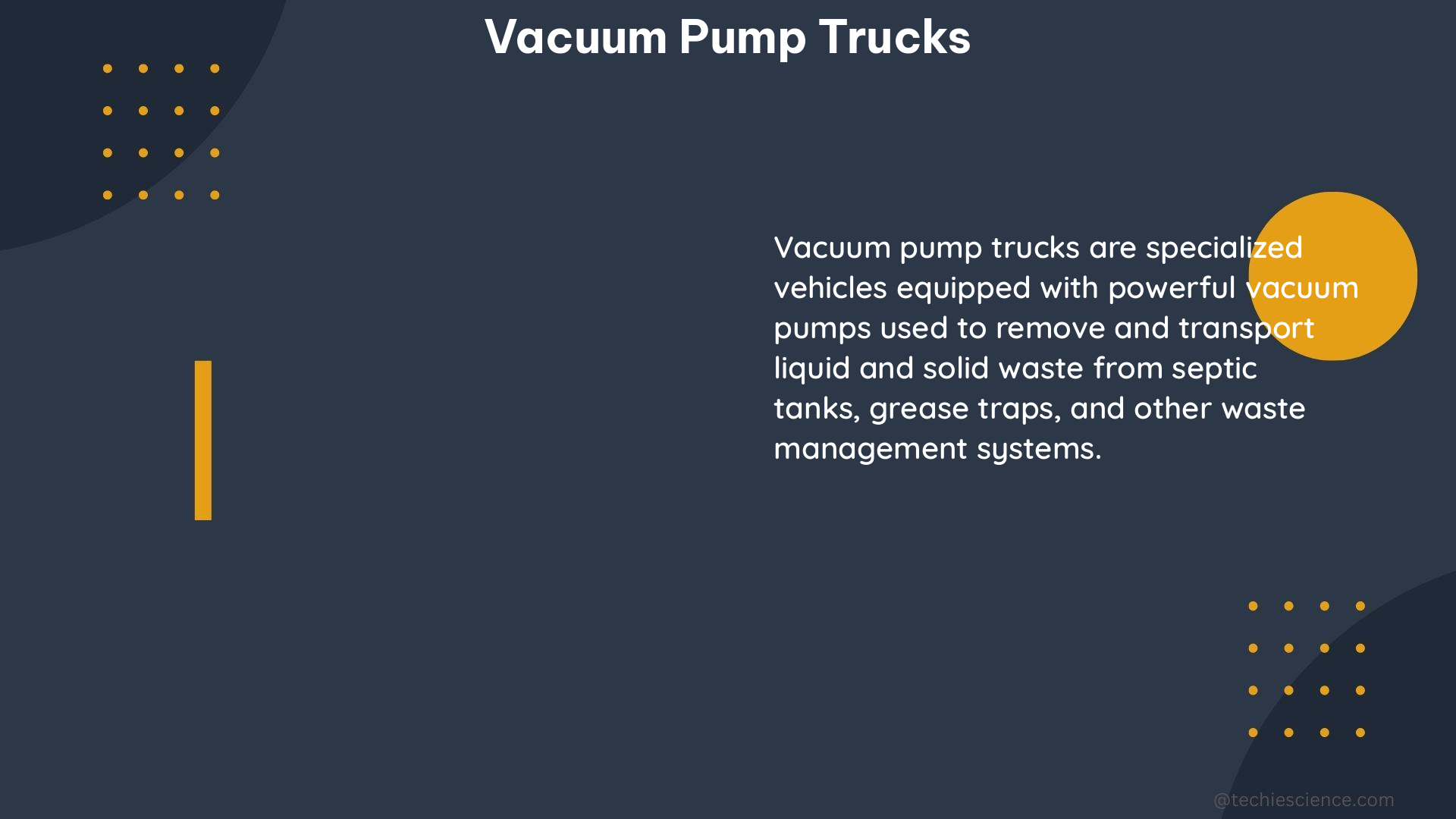Vacuum pump trucks are specialized vehicles equipped with powerful vacuum systems used for a variety of applications, such as cleaning up spills, removing sludge, and evacuating tanks. These trucks come in different sizes and configurations, with capacities ranging from 70bbl to 130bbl. The vacuum system typically consists of a vacuum pump, a cargo tank, and associated equipment mounted on a motor vehicle.
Vacuum Pump: The Heart of the System
The vacuum pump is a crucial component of these trucks, responsible for generating the necessary vacuum to move materials. Vacuum pumps can be classified into two main categories: positive displacement pumps and momentum transfer pumps.
Positive Displacement Pumps
Positive displacement pumps work by trapping a fixed volume of gas and then displacing it into the cargo tank. These pumps are known for their high suction power and ability to handle viscous materials. Common types of positive displacement pumps used in vacuum pump trucks include rotary vane pumps, rotary lobe pumps, and piston pumps.
Momentum Transfer Pumps
Momentum transfer pumps, on the other hand, use high-speed rotating blades to accelerate the gas, converting its kinetic energy into pressure. These pumps are often used for applications that require high flow rates, such as cleaning up large spills. Examples of momentum transfer pumps include centrifugal pumps and turbine pumps.
Pumping Speed and Vacuum Level
One important parameter for vacuum pumps is their pumping speed, which is usually measured in cubic feet per minute (CFM) or cubic meters per hour (m³/h). This value indicates the volume of gas that the pump can move in a given time. For instance, a typical vacuum pump truck might have a pumping speed of 5,000 CFM (141.6 m³/h).
Another key specification is the vacuum level that the pump can achieve. Vacuum is typically measured in inches of mercury (inHg), torr, or pascals (Pa). A higher vacuum level allows the truck to handle more demanding tasks, such as deep suction or the removal of high-viscosity materials. For example, a typical vacuum pump truck might be capable of generating a vacuum level of 25 inHg (-85 kPa).
Cargo Tank: The Holding Vessel

The cargo tank is another essential component of vacuum pump trucks. These tanks are designed to withstand the vacuum pressure and are typically made of materials like steel or aluminum. The tank capacity is a critical factor, as it determines the amount of material that the truck can transport in a single trip.
| Tank Capacity | Examples |
|---|---|
| 70bbl | Hull’s Environmental Services |
| 130bbl | Hull’s Environmental Services |
Additional Features and Specialized Equipment
In addition to the vacuum pump and cargo tank, vacuum pump trucks often include other features such as hoses, valves, and fittings, which allow the truck to connect to various types of containers and tanks. These trucks may also be equipped with specialized equipment, such as high-pressure water jetting systems, for specific applications.
Limitations and Considerations
When designing a pump station that utilizes vacuum trucks for emptying the wet well of debris, it is essential to consider the vacuum truck’s limitations. The maximum vacuum that can be achieved is approximately 30 feet (9.14 meters) of vertical lift, due to the limitations of atmospheric pressure. However, this depth can be increased by introducing air to aerate the sludge, which reduces the overall density of the material and allows for deeper suction.
Conclusion
Vacuum pump trucks are highly versatile vehicles used in various industries for the removal and transportation of hazardous and non-hazardous materials. Key specifications for these trucks include the pumping speed, vacuum level, cargo tank capacity, and any additional specialized equipment. When designing a system that utilizes vacuum trucks, it is essential to consider the truck’s limitations, such as the maximum vacuum that can be achieved, and how this can be influenced by factors such as the density of the material being removed.
References:
– Florida Department of Health. (n.d.). 64e-6.pdf. Retrieved from https://www.floridahealth.gov/environmental-health/onsite-sewage/forms-publications/_documents/64e-6.pdf
– Course Hero. (n.d.). Yet another way to monitor operations on a vacuum line. Retrieved from https://www.coursehero.com/file/pmlb967/Yet-another-way-to-monitor-operations-on-a-vacuum-line-is-to-use-your-hands-to/
– Chevron with Techron. (n.d.). Vacuum Truck and Vacuum System Operation Safe Work Practice. Retrieved from https://www.chevronwithtechron.com/content/dam/external/chevron/en_us/marketing-support/all-other/APVacuum-Truck-Vacuum-System-OperationsSWPStandard.docx
– Reddit. (2018, October 16). Using a vacuum/suction effect deeper than 30 feet? Retrieved from https://www.reddit.com/r/AskEngineers/comments/9oqwfx/using_a_vacuumsuction_effect_deeper_than_30_feet/
– Hull’s Environmental Services. (n.d.). Types of Vacuum Trucks. Retrieved from https://www.hullsenvironmental.com/types-of-vacuum-trucks/

The lambdageeks.com Core SME Team is a group of experienced subject matter experts from diverse scientific and technical fields including Physics, Chemistry, Technology,Electronics & Electrical Engineering, Automotive, Mechanical Engineering. Our team collaborates to create high-quality, well-researched articles on a wide range of science and technology topics for the lambdageeks.com website.
All Our Senior SME are having more than 7 Years of experience in the respective fields . They are either Working Industry Professionals or assocaited With different Universities. Refer Our Authors Page to get to know About our Core SMEs.